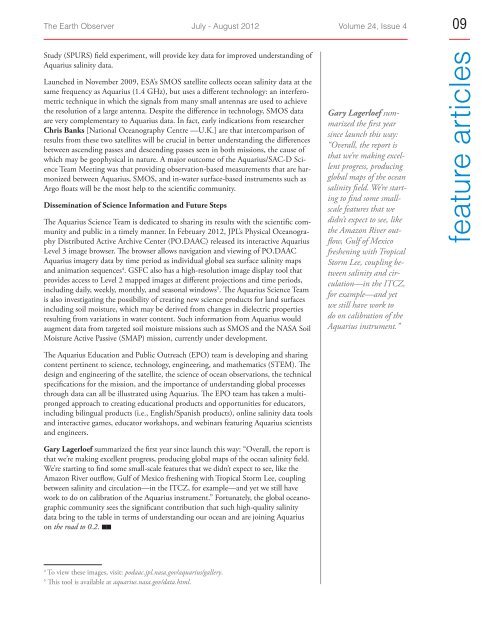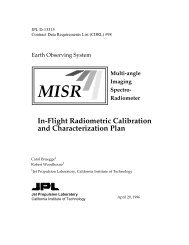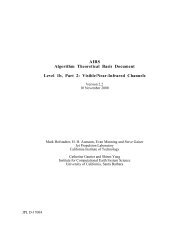Download - NASA's Earth Observing System
Download - NASA's Earth Observing System
Download - NASA's Earth Observing System
Create successful ePaper yourself
Turn your PDF publications into a flip-book with our unique Google optimized e-Paper software.
The <strong>Earth</strong> Observer July - August 2012 Volume 24, Issue 4 09<br />
Study (SPURS) field experiment, will provide key data for improved understanding of<br />
Aquarius salinity data.<br />
Launched in November 2009, ESA’s SMOS satellite collects ocean salinity data at the<br />
same frequency as Aquarius (1.4 GHz), but uses a different technology: an interferometric<br />
technique in which the signals from many small antennas are used to achieve<br />
the resolution of a large antenna. Despite the difference in technology, SMOS data<br />
are very complementary to Aquarius data. In fact, early indications from researcher<br />
Chris Banks [National Oceanography Centre —U.K.] are that intercomparison of<br />
results from these two satellites will be crucial in better understanding the differences<br />
between ascending passes and descending passes seen in both missions, the cause of<br />
which may be geophysical in nature. A major outcome of the Aquarius/SAC-D Science<br />
Team Meeting was that providing observation-based measurements that are harmonized<br />
between Aquarius, SMOS, and in-water surface-based instruments such as<br />
Argo floats will be the most help to the scientific community.<br />
Dissemination of Science Information and Future Steps<br />
The Aquarius Science Team is dedicated to sharing its results with the scientific community<br />
and public in a timely manner. In February 2012, JPL’s Physical Oceanography<br />
Distributed Active Archive Center (PO.DAAC) released its interactive Aquarius<br />
Level 3 image browser. The browser allows navigation and viewing of PO.DAAC<br />
Aquarius imagery data by time period as individual global sea surface salinity maps<br />
and animation sequences 4 . GSFC also has a high-resolution image display tool that<br />
provides access to Level 2 mapped images at different projections and time periods,<br />
including daily, weekly, monthly, and seasonal windows 5 . The Aquarius Science Team<br />
is also investigating the possibility of creating new science products for land surfaces<br />
including soil moisture, which may be derived from changes in dielectric properties<br />
resulting from variations in water content. Such information from Aquarius would<br />
augment data from targeted soil moisture missions such as SMOS and the NASA Soil<br />
Moisture Active Passive (SMAP) mission, currently under development.<br />
Gary Lagerloef summarized<br />
the first year<br />
since launch this way:<br />
“Overall, the report is<br />
that we’re making excellent<br />
progress, producing<br />
global maps of the ocean<br />
salinity field. We’re starting<br />
to find some smallscale<br />
features that we<br />
didn’t expect to see, like<br />
the Amazon River outflow,<br />
Gulf of Mexico<br />
freshening with Tropical<br />
Storm Lee, coupling between<br />
salinity and circulation—in<br />
the ITCZ,<br />
for example—and yet<br />
we still have work to<br />
do on calibration of the<br />
Aquarius instrument.”<br />
feature articles<br />
The Aquarius Education and Public Outreach (EPO) team is developing and sharing<br />
content pertinent to science, technology, engineering, and mathematics (STEM). The<br />
design and engineering of the satellite, the science of ocean observations, the technical<br />
specifications for the mission, and the importance of understanding global processes<br />
through data can all be illustrated using Aquarius. The EPO team has taken a multipronged<br />
approach to creating educational products and opportunities for educators,<br />
including bilingual products (i.e., English/Spanish products), online salinity data tools<br />
and interactive games, educator workshops, and webinars featuring Aquarius scientists<br />
and engineers.<br />
Gary Lagerloef summarized the first year since launch this way: “Overall, the report is<br />
that we’re making excellent progress, producing global maps of the ocean salinity field.<br />
We’re starting to find some small-scale features that we didn’t expect to see, like the<br />
Amazon River outflow, Gulf of Mexico freshening with Tropical Storm Lee, coupling<br />
between salinity and circulation—in the ITCZ, for example—and yet we still have<br />
work to do on calibration of the Aquarius instrument.” Fortunately, the global oceanographic<br />
community sees the significant contribution that such high-quality salinity<br />
data bring to the table in terms of understanding our ocean and are joining Aquarius<br />
on the road to 0.2. ••<br />
4<br />
To view these images, visit: podaac.jpl.nasa.gov/aquarius/gallery.<br />
5<br />
This tool is available at aquarius.nasa.gov/data.html.







